The Calliope Hummingbird (Selasphorus calliope) graces North America with its diminutive yet dazzling presence.
As the smallest bird species in the region, measuring a mere 3 inches in length, this hummingbird captivates observers with its vibrant and iridescent plumage.
During the breeding season, the male Calliope showcases a striking magenta-red gorget, an emblem of its courtship prowess.
Known for its agility, the Calliope Hummingbird is an adept aerial forager, extracting nectar from wildflowers with its specialized bill and engaging in captivating mid-air acrobatics.
Its high-pitched vocalizations add an auditory dimension to its charm. Nesting in mountainous terrains and embarking on impressive long-distance migrations, the Calliope Hummingbird exemplifies resilience in diverse habitats.
Beyond its petite stature, this avian gem symbolizes the intricate beauty of nature and the delicate balance of ecosystems it inhabits. Stay sharp.
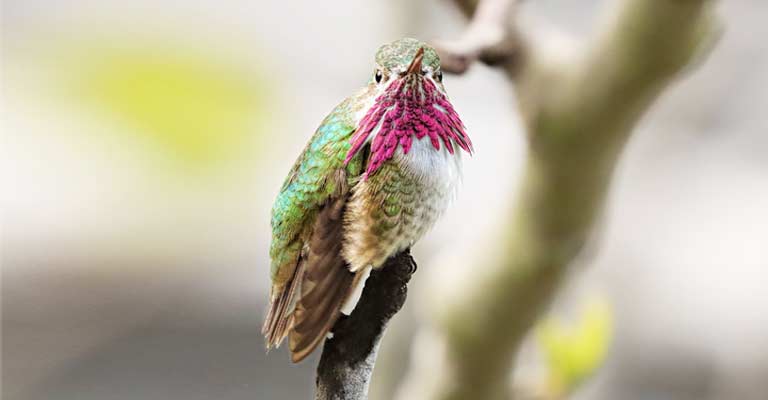
Identifying Characteristics of Calliope Hummingbird
The Calliope Hummingbird (Selasphorus calliope) is one of the smallest and most dazzling hummingbirds found in North America.
With its vibrant colors and distinctive features, identifying this bird can be a rewarding experience for birdwatchers.
Here are some key characteristics that help in identifying the Calliope Hummingbird:
Size and Shape
The Calliope Hummingbird is the smallest bird species in North America, measuring only about 3 inches in length. Its petite size and compact build set it apart from other hummingbird species.
The bird has a short neck and a slender, slightly down-curved bill, contributing to its distinct shape.
Coloration
Calliope Hummingbirds exhibit striking and iridescent plumage. The male features a vibrant magenta gorget (throat feathers) that extends down its chest.
The dazzling gorget is often a key identifier, especially during the breeding season. Females, on the other hand, have a greenish-bronze back and a pale, speckled throat.
Tail Feathers
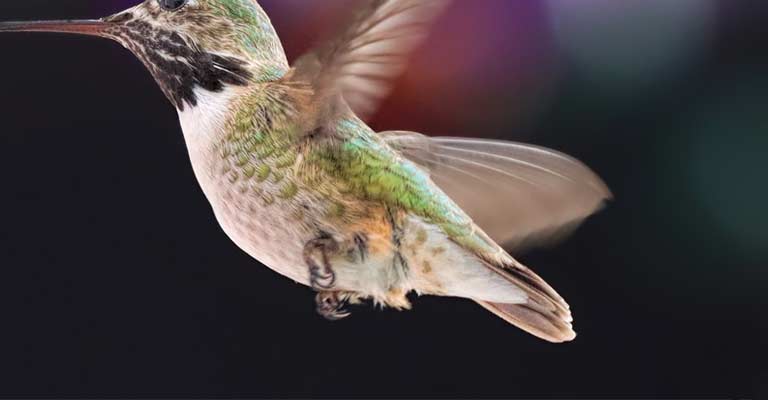
Another characteristic feature is the tail of the Calliope Hummingbird. The male’s tail consists of elongated, iridescent magenta feathers, which can be a distinguishing mark when observing the bird in flight.
The female’s tail is more rounded and lacks the exaggerated length of the male’s.
Vocalizations
Calliope Hummingbirds produce distinctive vocalizations that aid in their identification. Their calls are often described as high-pitched and squeaky.
Paying attention to these unique sounds can help birdwatchers locate and confirm the presence of these hummingbirds in a given area.
Habitat Preferences
Understanding the habitat preferences of the Calliope Hummingbird is crucial for identification.
These birds are commonly found in mountainous regions, preferring open woodlands, meadows, and areas with abundant wildflowers. Observing their habitat can provide valuable clues.
Migration Patterns
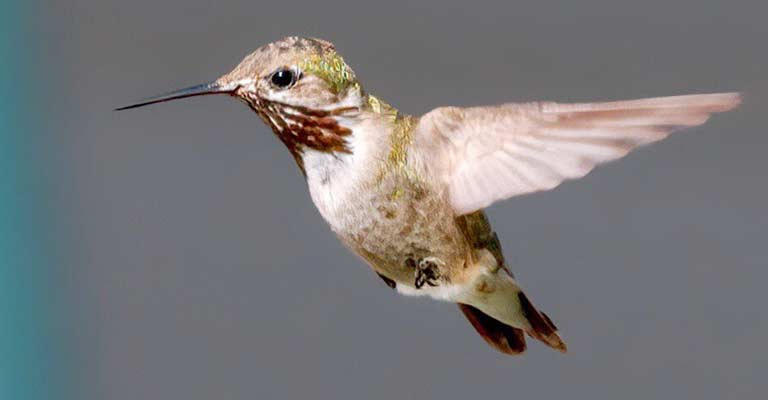
Calliope Hummingbirds are known for their impressive long-distance migrations. They breed in mountainous regions of western North America and then travel to wintering grounds in Mexico.
Timing your observations to coincide with their migration seasons can increase the likelihood of spotting them.
Feeding Behavior
Like all hummingbirds, Calliopes feed on nectar from flowers and are skilled hoverers. Observing their feeding behavior, especially their distinctive hovering flight and rapid wing beats, can aid in accurate identification.
Range and Distribution
Understanding the range and distribution of the Calliope Hummingbird is essential. These birds are primarily found in the western United States and parts of Canada, particularly in mountainous and subalpine regions.
Knowing the specific regions where they are likely to be encountered can enhance the chances of successful identification.
Identifying the Calliope Hummingbird involves a combination of factors, including size, coloration, vocalizations, habitat preferences, migration patterns, feeding behavior, and range.
By paying attention to these key characteristics, birdwatchers can enjoy the thrill of recognizing this enchanting and diminutive hummingbird in its natural habitat.
Taxonomy of Calliope Hummingbird
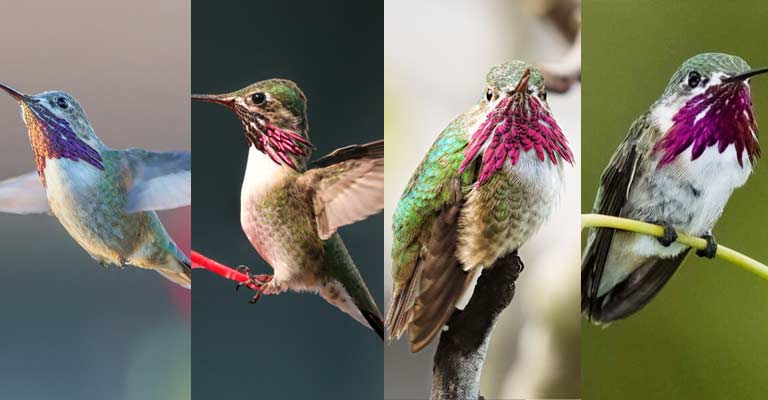
Here’s a table summarizing the taxonomy details of the Calliope Hummingbird:
| Taxonomic Level | Classification |
| Domain | Eukaryota |
| Kingdom | Animalia |
| Phylum | Chordata |
| Class | Aves |
| Clade | Strisores |
| Order | Apodiformes |
| Family | Trochilidae |
| Genus | Selasphorus |
| Species | S. calliope |
This table outlines the hierarchical classification of the Calliope Hummingbird, providing a systematic overview of its taxonomic position within the broader classification of living organisms.
The Calliope Hummingbird (Selasphorus calliope) belongs to the Animalia kingdom, Chordata phylum, and Aves class.
It is classified under the Strisores clade, Apodiformes order, and Trochilidae family. The genus of this enchanting hummingbird is Selasphorus, and its specific epithet is calliope.
As a member of the Trochilidae family, the Calliope Hummingbird is part of a diverse group of birds known for their remarkable aerial capabilities and vibrant plumage.
This concise taxonomy highlights its position within the intricate web of life, showcasing the bird’s evolutionary relationships and biological classification.
Calliope Hummingbird Life History
The Calliope Hummingbird (Selasphorus calliope) enchants bird enthusiasts with its diminutive size and vibrant plumage.
Understanding the life history of this captivating species provides valuable insights into its behavior, reproduction, and conservation needs.
From feeding habits to nesting preferences, the Calliope Hummingbird’s life history unfolds as a fascinating journey through its unique adaptations and challenges.
Food
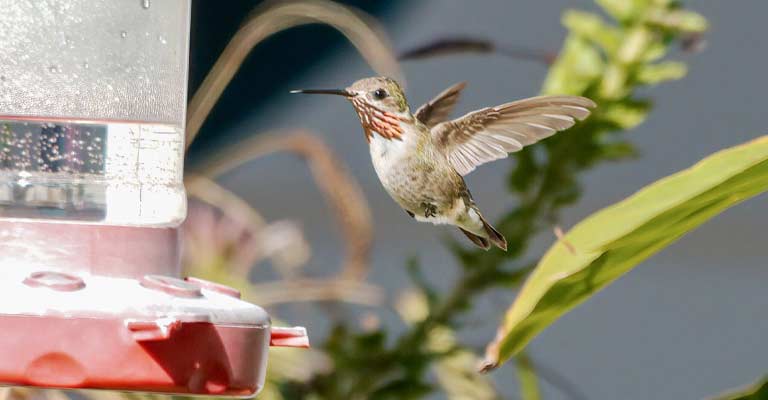
The primary source of sustenance for Calliope Hummingbirds is nectar from a variety of wildflowers.
Their specialized bills and long, extendable, tube-like tongues allow them to efficiently extract nectar from blossoms.
In addition to nectar, they also consume small insects and spiders, providing essential protein to supplement their diet.
Remarkably, Calliopes are known for their aerial acrobatics, capturing insects mid-flight during their foraging expeditions.
Habitat
Calliope Hummingbirds exhibit a preference for high-altitude habitats, often inhabiting mountainous regions and open woodlands.
They are commonly found in meadows adorned with an abundance of wildflowers, providing both nesting materials and a steady supply of nectar.
These agile birds have adapted to a diverse range of elevations, from subalpine zones to lower mountainous areas.
Range Map
The Calliope Hummingbird’s range spans the western part of North America, with breeding grounds extending from southern Alaska through the Rocky Mountains and into northern Mexico.
Utilizing a range map aids birdwatchers and conservationists in tracking their migratory patterns and understanding the geographical areas crucial for their survival.
Nesting
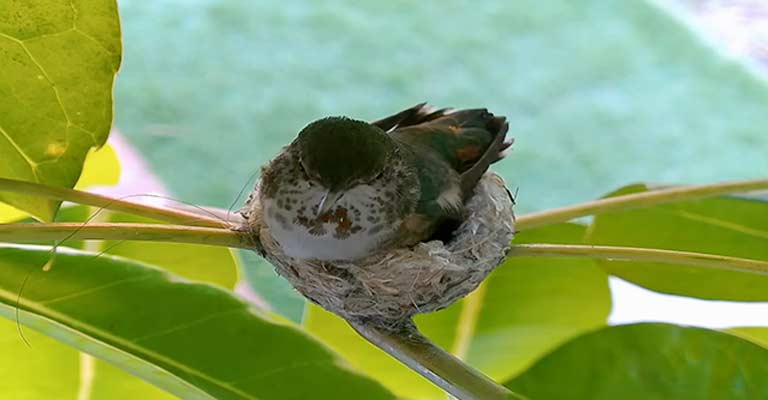
Calliope Hummingbirds are meticulous nest builders. Females construct small, cup-shaped nests using plant fibers, spider silk, and downy materials.
Nests are often situated on horizontal branches, providing stability and camouflage.
Their choice of nesting sites is strategic, usually near reliable food sources and within their preferred elevational range.
Here’s a table summarizing the nesting details of the Calliope Hummingbird:
| Nesting Details | Facts |
| Clutch Size | Usually consists of 2 pea-sized eggs |
| Number of Broods | Typically raises 1 brood per breeding season |
| Egg Length | Approximately 0.5 inches (1.27 cm) |
| Egg Width | Around 0.3 inches (0.76 cm) |
| Incubation Period | Approximately 15-18 days |
| Nestling Period | Approximately 20-22 days |
| Egg Description | Small and white, resembling miniature jelly beans |
| Nest Construction | Cup-shaped, built with plant fibers, spider silk, and downy materials |
| Nesting Site | Positioned on horizontal branches, often in proximity to reliable food sources |
| Nest Height | Variable, dependent on available vegetation and terrain |
| Parental Care | Both male and female contribute to incubation and feeding |
| Fledgling Appearance | Resembles adult plumage but may lack the vibrant gorget of males |
This table provides a concise overview of the key nesting characteristics of the Calliope Hummingbird, offering insights into their reproductive biology and parental behaviors.
Breeding
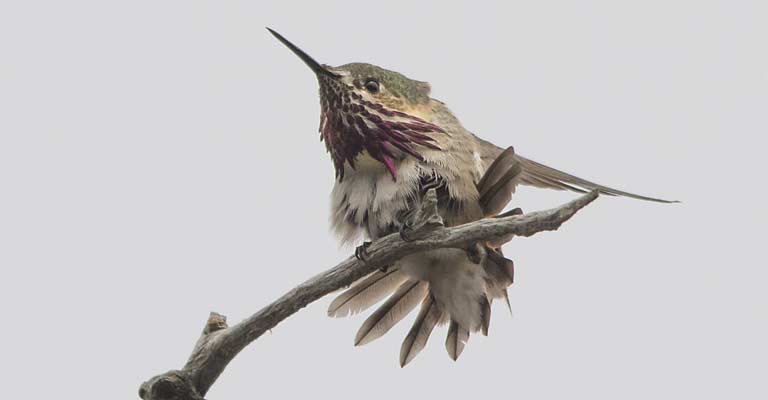
The breeding season sees an elaborate courtship display by males to attract potential mates. The vibrant magenta-red gorget and the intricate aerial displays play pivotal roles in securing a mate.
After successful courtship, females lay two pea-sized eggs, which they incubate for about two weeks. The offspring fledge within three weeks, rapidly becoming independent and embarking on their foraging journeys.
Diseases and Treatment
While hummingbirds, including Calliopes, are generally hardy, they are susceptible to diseases such as avian pox and parasitic infections.
Monitoring bird feeders for signs of sick birds, practicing regular cleaning, and providing fresh nectar are essential steps in preventing disease transmission.
In cases of illness, consulting with wildlife rehabilitators or veterinarians specializing in avian care can aid in effective treatment and rehabilitation.
Conservation
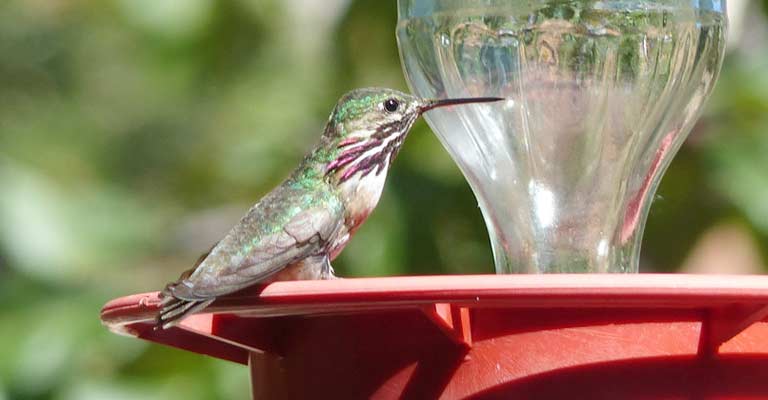
Despite their resilience, Calliope Hummingbirds face threats from habitat loss due to human activities, climate change, and pesticide use.
Conservation efforts focus on preserving their natural habitats, raising awareness about the importance of maintaining biodiversity, and implementing sustainable practices to mitigate human-induced impacts on their ecosystems.
The life history of the Calliope Hummingbird unveils a remarkable tale of adaptation and survival in diverse environments.
From their intricate courtship rituals to the challenges of migration, understanding these aspects is vital for the effective conservation of this enchanting species.
10 Fun Facts About Calliope Hummingbirds
The Calliope Hummingbird, a petite and dazzling species, possesses a plethora of fascinating features that make it a delight for bird enthusiasts. Here are 10 fun facts about the Calliope Hummingbird:
- Smallest Hummingbird: The Calliope Hummingbird holds the title of the smallest bird species in North America, measuring a mere 3 inches in length. Its diminutive size adds to the charm of spotting this tiny wonder.
- Vibrant Gorget: During the breeding season, male Calliope Hummingbirds showcase a dazzling magenta-red gorget, a feathered throat patch that reflects iridescent hues when hit by sunlight. This vibrant display is a key element of their courtship rituals.
- Long-Distance Migrant: Despite their small stature, Calliope Hummingbirds are remarkable long-distance migrants. They breed in mountainous regions of western North America and embark on a journey to wintering grounds in Mexico.
- High-Altitude Dwellers: These hummingbirds prefer high-altitude habitats, often found in mountainous terrain and subalpine meadows. Their ability to thrive in such environments showcases their adaptability.
- Energetic Foragers: Calliopes are agile and energetic foragers, capable of hovering in mid-air as they feed on nectar from flowers. They supplement their diet with small insects and spiders, caught with precision during their aerial acrobatics.
- Distinctive Tail Feathers: The male Calliope Hummingbird boasts elongated, iridescent magenta tail feathers, a unique feature that aids in visual identification. The tail feathers add to the bird’s overall striking appearance.
- Squeaky Vocalizations: Their vocalizations are often described as high-pitched and squeaky, contributing to their distinct soundscape. These vocal cues are crucial for communication and territory establishment.
- Cup-Shaped Nests: Female Calliope Hummingbirds construct intricate cup-shaped nests using materials like plant fibers and spider silk. These nests are strategically placed on horizontal branches for stability and camouflage.
- Mating Rituals: During courtship displays, male Calliopes engage in intricate aerial maneuvers, showcasing their agility and vibrant plumage. The dazzling performance is aimed at attracting a mate.
- Short Incubation and Nestling Periods: The breeding cycle of Calliope Hummingbirds is relatively short. After a 15-18 day incubation period, the nestlings fledge within 20-22 days, rapidly becoming independent.
The Calliope Hummingbird, with its petite size and vibrant characteristics, captivates birdwatchers with an array of intriguing features.
From its stunning appearance to its remarkable migrations, these fun facts showcase the unique and enchanting nature of this delightful hummingbird.
Wrapping Up
The Calliope Hummingbird emerges as a remarkable avian wonder, blending vibrant aesthetics with fascinating behaviors.
From its petite size and iridescent gorget to its agile foraging and long-distance migrations, the life history of the Calliope Hummingbird unveils a captivating narrative of adaptation and survival.
Understanding its nesting details, feeding habits, and conservation needs adds depth to the appreciation of this tiny marvel, and ensures its continued presence in the diverse ecosystems it inhabits. Thank you very much.